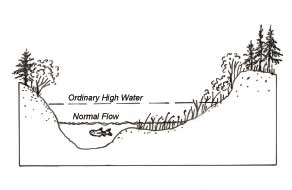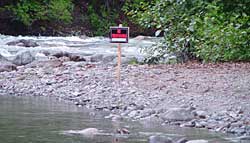Alaska Fish & Wildlife News
September 2010
Public Access to Alaska Waters
Fishing and Boating Access is Protected

Every year Alaskans migrate outdoors to enjoy our abundant opportunities for recreation on Alaska's rivers, lakes, and streams. Accordingly, each spring and summer, the Alaska Department of Fish and Game receives calls from the public requesting information regarding use of Alaska's waterways. Many of these calls come from frustrated fishers and boaters who arrived at a favorite stream and found posted signs or were accosted by landowners claiming ownership of the stream and the submerged lands under it.
In Alaska, the public has a constitutional right to access on and use of navigable and public waters regardless of who owns the underlying bed. This right is defined in Article VIII, Section 14, of the Alaska Constitution, which states: "Free access to the navigable or public waters of the state, as defined by the legislature, shall not be denied any citizen of the United States or resident of the state …." This section of the constitution also empowered the state legislature to define navigable and public waters. A navigable water body under state law includes any water of the state that is navigable in fact for any useful purpose including boating, hunting, fishing, and other recreational activities (AS 38.05.965(13)). Public water, as defined in state statute, includes navigable water and all other water that is reasonably suitable for public use and utility including habitat for fish and wildlife in which there is a public interest (AS 38.05.965(18)).
The Alaska Constitution and state statutes protect the public's right to use navigable or public waters. Under Alaska law, ownership of uplands adjacent to navigable or public water does not grant an exclusive right to use the water or to control public use of the water, even if the title includes the submerged land. Any land below the ordinary high water mark of navigable or public waters is subject to the right of the people to use for recreational or other purposes consistent with the public trust (AS 38.05.126). Such uses include fishing, trapping, boating, and hunting. Use of the water and land below the ordinary high water mark is not considered trespassing. On the contrary, it is a misdemeanor to interfere with or obstruct a person's free passage or use of navigable water, including the land below the ordinary high water mark. Accordingly, the state holds the view that the public's right to use navigable or public waters also includes the right to walk or stand on the lake or streambed below the ordinary high water mark.

Along non-tidal waters, the ordinary high water mark can usually be identified by the vegetation line or a physical line indicated by erosion, shelving, or changes in soil characteristics along the streambank or lake shore. In a braided river or stream, the area below the ordinary high water mark includes everything between the ordinary high water marks on the outside margin of the most distant channels.
While permission from the adjacent upland owner is not required for use of the water or land below the ordinary high water mark, the right to use the water does not include the right to enter, cross, or use private uplands except as minimally necessary to portage around obstacles or obstructions. River users should not assume the adjacent uplands are open for any use.

At the Department of Fish and Game, public access issues are addressed by a small, but dedicated staff in the Division of Sport Fish, Access and Defense Program that works in partnership with the Alaska Department of Natural Resources and federal resource agencies. Access and Defense staff work cooperatively with these agencies to assist the public with access questions and to resolve issues statewide involving public access and state authorities over fish, wildlife, and water. One way that Access and Defense staff protect public access is by reviewing federal, state, and municipal land management plans and land conveyances to ensure that navigable waterways and other easements are protected as land is transferred across jurisdictions or into private hands. The Access and Defense staff also investigates historical and modern uses of state waters to help determine which water bodies are in fact navigable under federal law, which means the lands underlying the waterway are owned by the state.
For further information contact the Sport Fish Information Center at the Department of Fish and Game offices in Anchorage or the Public Access Assertion and Defense unit at the Department of Natural Resources.
Dave Ryland is a biologist and navigable waters program leader who works for Division of Sport Fish in Anchorage.
Subscribe to be notified about new issues
Receive a monthly notice about new issues and articles.
